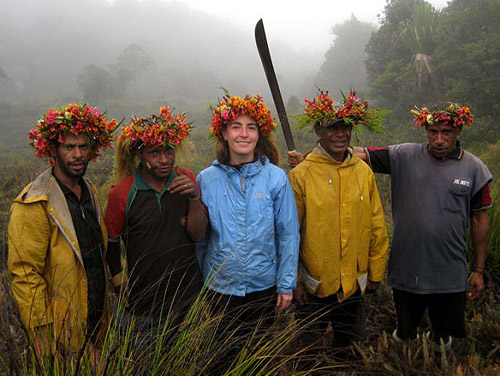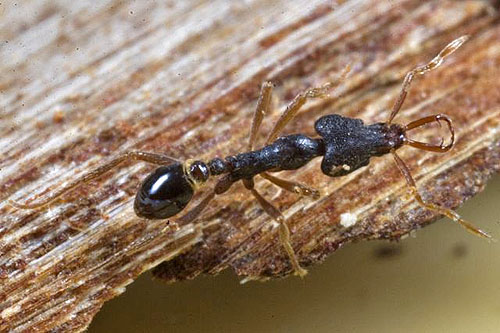[a guest post by myrmecologist Andrea Lucky]
 Andrea & her intrepid field team in New Guinea
Andrea & her intrepid field team in New GuineaIt was a dark and stormy night...
...actually, it was a dark and stormy morning. The dawn of the 7th day of ceaseless frigid rain to be precise, and I was reminiscing about the grand old days one week before when the sun emerged and for a glorious 10 minutes it was warm enough to splash some water on my arms, legs and neck and wipe away the accumulated grime that is synonymous with field work. I wondered if that lovely burst of sunshine would ever come again (no, it wouldn't), and every time I shiveringly remembered my quick bath I cursed myself for wasting those precious moments of sun. Washing - what was I thinking? I should have been out there looking for ants!
Papua New Guinea is a tropical paradise for any biologist, but especially for an ant biologist.
E.O. Wilson began his pioneering work on the theory of Island Biogeography and the Taxon Cycle there, and Jared Diamond's Rules of Community Assembly were born there. Combine the vision of PNG as the crucible of species diversification with the fact that so many species there remain unknown to science, and the pull is irresistible.
I had made plans on and off for years before I finally found myself in this lush, mysterious, promised land, thanks to Conservation International's Rapid Assessment Program. And finally, after intensive surveying in the lowlands, I was on a mountain top in PNG with the goal of collecting as many highland ants as possible. After the first long day at our new site I feared that the worst had happened - we had crossed the Ant Line, and there were no ants at all to be found.
Imagine - a lush tropical forest, dripping with epiphytes, and so cushioned with spongy mosses that you practically bounce back up if you stumble on the trail. Ideal ant habitat everywhere you look: decaying logs on the ground, half-rotten standing stumps, treefalls full of debris and twigs and leaf litter like a backyard compost pile. But here's the eerie part: no ants, none at all. If you shook out every root and clump of that leaf litter, you might find a spider, a collembolan, or maybe an earthworm, but search until you drop (I did) and you will still find no ants. The forests and meadows were beautiful, and familiarly tropical, but when I remembered that they were antless I suddenly felt like I was in a spooky parallel universe to the world I've come to know.
Our field site stood at nearly 3000m in elevation, which was well beyond the Ant Line, or elevational limit, for ants in New Guinea. The highest collections were made in the 1950s at approximately 2500m, and based on that fact E.O. Wilson ominously pronounced that "All present evidence points to the complete absence of a high alpine ant fauna in New Guinea."* Scarcity I could believe, but the absence of ants here seemed impossible!
Each morning that week, I stepped out of my little yellow tent into the cold soggy, squelching, breathtakingly beautiful scenery, charged with a mission to prove the Ant Line wrong. I sifted through mountains of leaf litter, I dug into the rootlets of ferns, I picked apart the razor-edged leaves of a Pandanus tree, I even had the chance to inspect the canopy branches of an emergent hardwood that had been felled - not a single ant was to be seen. By the seventh day, with our departure rapidly approaching, I was fighting off dismay - I knew I had little time left.
In a flash of inspiration (despair seemed the right word at the time), I got serious about finding any possible ant habitats that I might have overlooked. I knew that if only I could find a well-drained log that wasn't totally saturated with moisture, I might have a chance of finding some slow-moving ant that was ekeing out a living despite the cold and wet conditions. Several hours' worth of searching produced a likely candidate: a log half buried in the ground, hollow on the inside, but firm, not rotten on the outside. I began to dig. And dig, and dig. Incredibly, when I looked closely, several of the shiniest bits of soil began to move! This was an entire colony of ants - they were in fact the ant genus I might have expected to be living a slow life in a chilly, soggy hollow - Hypoponera! I've never been so happy to see such a boring ant in my entire life. But finally, all of my searching had paid off and the Ant Line record had been shattered! Â Then it occurred to me - if there is one species of ant up here, surely there must be more...
So with renewed vigor I set about looking into all the nooks and crannies that an ant might call home. Later that day I stripped a mat of epiphytes off of the trunk of a Pandanus tree and spent the evening chopping apart the roots and stems and tendrils and tubers and stuffing them into leaf-litter extractors, hoping wildly for something, anything, to fall into the hopeful cups at the bottom of the bags.
The next morning (still raining) I leapt up to check on my bags and saw from a distance what looked like empty collection cups. Still, I looked carefully, in fact I put the collection cups under the scope I had lugged out there with me, and amidst the debris and dirt and flakes of bark and leaves and rootlets and fungus, there was a single, lovely, dark brown ant, and it was a different species from the other one I had found! In fact, it belonged to a distinct subfamily - this was the genus Strumigenys, the trapjaw ant which walks around with its mandibles stretched wide, just waiting to snap them shut upon unsuspecting prey. So now I had two species and only a single day left to keep hunting.
Well, to make a long story short, I stripped and meticulously picked apart so many mats of epiphytes clinging to Pandanus trunks that day that I nearly went cross-eyed. I would have lost heart except halfway through the day I found a single, miniscule male ant (probably belonging to that same species of Strumigenys) and was again full of fire to find more ants!
The grand haul of two species of ants may seem underwhelming for having traveled to an uncollected wilderness halfway across the world, but the fact that the Ant Line now rests firmly at 3000m in PNG is new (albeit small) piece of knowledge about how and where ants are distributed around the world. As to just why these 'high' elevations in the tropics are so inhospitable to ants, when temperate latitudes host ants well up to 4,000m , that is a topic still being investigated today. Hopefully these ant-sized contributions can offer a glimpse into the patterns of life that abound all around us.
*Wilson, E.O. (1958) Studies on the ant fauna of Melanesia. Bulletin of the Museum of Comparative Zoology at Harvard College 118(3): 101-153. Quote from p. 103.
- Log in to post comments




Wow! An ant Bermuda Triangle! Maybe the scarcity is due to some other organisms(probably some other insects) that fill in niches occupied by ants on other parts of the globe?
Either that, or aliens are abducting them to study them as a model for human social behavior, which would 1) also explain the recent CCD thing, and 2) be yet another bad case of confusing rather altruistic insect societies with selfish human societies.
Ah, the thrill of the hunt - great story! It's not everyday that you get a chance to prove E. O. Wilson wrong.
Nice. Lucky, indeed.
1. Awesome story! Congrats!
2. @ Ted, Roberto, and Al, lol Wilson FAIL, Wilson PWNED, O'Doyle RULZ ... i mean Lucky RULZ!!
Howdy Andrea:
Great collecting story and a good read, too. Is there an image of the PNG Strumigenys?
Enjoyed this post very much, thanks for sharing!
Hi James,
That's the record-breaker there in the first ant photo - the species is not yet unidentified. The second one (S. cf tigris) was from a lower elevation, but seemed worth including as it is such a lovely ant.
A great story. Thanks for the look into the life of a myrmecologist.
Great post, Andrea! Congrats for extending the Ant Line.
What a terrific adventure. And people often wonder what's so exciting about collecting and studying ants.
Hah! I saw a Neotropical Nylanderia with a pattern of bold yellow and dark brown bands like the Strumigenys and thought to myself, if I were to name this, I'd call it "tigrina".
I agree this is a great story. But I don't know ho wwmuch time I'd want to spend with the guy on the right in the picture. Something about the look mixed with the machete.